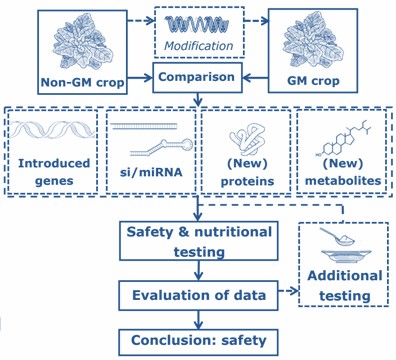Lifeasible facilitates the application of RNA interference in plant protection and provides services to evaluate the safety of RNA interference. We perform customized safety assessments based on different safety assessment needs.
RNA interference, including host-induced gene silencing (HIGS) and spray-induced gene silencing (SIGS), can be used to make a significant contribution to integrated pest management and sustainable agriculture strategies. While HIGS requires editing of plant genes, SIGS does not alter the plant’s genetic information. Therefore, the current safety assessment of RNA interference in plant protection mainly focuses on genetic manipulation (GM)-based HIGS. Adequate safety assessment is essential for applying RNA interference in plant protection. Preliminary bioinformatics-based safety assessments help to rule out unsafe RNA interference early. Experimental tests are likewise needed to assess the safety of RNA interference. Fig. 1 shows the methods for the safety assessment of GM crops modified with RNA interference.
 Fig. 1 Comparative safety assessment approach for GM crops modified with RNA interference (Kleter, 2020).
Fig. 1 Comparative safety assessment approach for GM crops modified with RNA interference (Kleter, 2020).
Molecular safety assessment of RNA interference
We provide to assess the molecular safety of HIGS, including assessment of the exogenous insert gene's integrity and stability, transcription stability, RNA interference stability, and off-target effects. For SIGS, we provide the safety assessment of RNA interference stability and off-target effects. When using organisms such as bacteria and yeast for sRNA production, we assess the integrity, stability, and transcriptional stability of the edited genes.
Environmental safety assessment of RNA interference
For HIGS, we provide the safety assessment of genetic stability, gene silencing of non-target organisms, and residual time of sRNAs in various environments. For SIGS, we provide assessments of encapsulation material safety, silencing of non-target organisms, and degradation of sRNAs. We add the corresponding environmental safety assessment for other organisms that produce sRNAs depending on the environment involved.
Food safety assessment of RNA interference
We offer services to help assess whether RNA interference poses new food safety risks. We help analyze the changes in plant metabolism and nutrient deviations caused by RNA interference and analyze whether RNA interference leads to toxic substances.
Bioinformatics-based early safety assessment
We use bioinformatics to search for potential RNA interference targets in and out of target organisms through currently available gene and RNA libraries to comprehensively assess the off-target potential of RNA interference and the potential to target unintended targets.
Experiment-based scientific safety assessment
We provide experimental research to explore the degradation of RNA encapsulation materials, sRNAs, and encapsulated sRNAs in the environment to initially assess the duration of residual environmental hazards. In addition, we offer to apply RNA encapsulating materials, sRNAs, and encapsulated sRNAs to non-target organisms to explore their potential undesirable effects on non-target organisms. For other organisms that produce sRNAs, we will perform customized experiment assessments.
Omics-based holistic safety assessment
We offer to assess the safety of RNA interference-modified plants based on similarity to safe plant species. We offer to use omics methods (such as transcriptomics, metabolomics, and RNomics) to assess molecular, protein, and metabolic differences between RNA interference-modified plants and the original plants. And we offer to evaluate the safety of differential molecules, proteins, and metabolites.
Lifeasible provides customized safety assessment services for RNA interference-modified plants. We will design safety assessment experiments according to the client's needs. After receiving confirmation from the client, we will complete the safety assessment experiment. Please contact us to customize the RNA interference safety assessment.
References
Lifeasible has established a one-stop service platform for plants. In addition to obtaining customized solutions for plant genetic engineering, customers can also conduct follow-up analysis and research on plants through our analysis platform. The analytical services we provide include but are not limited to the following:
Get Latest Lifeasible News and Updates Directly to Your Inbox
Adaptive Evolutionary Mechanism of Plants
February 28, 2025
Unraveling Cotton Development: Insights from Multi-Omics Studies
February 27, 2025